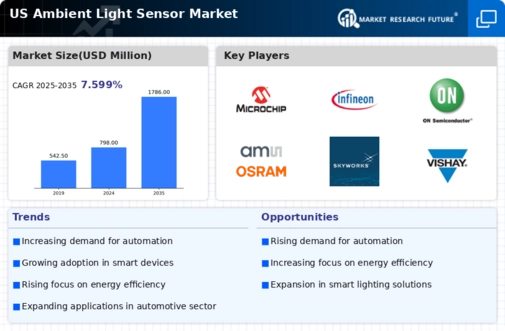Growing Adoption of IoT Devices
The ambient light-sensor market is benefiting from the rapid proliferation of Internet of Things (IoT) devices in the US. As smart homes and connected devices become more prevalent, the integration of ambient light sensors into these systems is becoming increasingly common. These sensors enable devices to respond intelligently to changes in lighting conditions, enhancing user experience and energy efficiency. The IoT market is expected to reach $1 trillion by 2025, with ambient light sensors playing a pivotal role in this ecosystem. This growth is indicative of a broader trend towards automation and smart technology, suggesting that the ambient light-sensor market will continue to expand as more consumers embrace IoT solutions in their daily lives.
Increased Focus on Energy Conservation
The ambient light-sensor market is significantly influenced by the heightened focus on energy conservation initiatives in the US. With energy costs rising and environmental concerns becoming more pressing, both residential and commercial sectors are prioritizing energy-efficient solutions. Ambient light sensors contribute to this effort by automatically adjusting lighting based on natural light availability, thereby reducing unnecessary energy consumption. Reports indicate that buildings equipped with these sensors can achieve energy savings of up to 30%. As regulatory bodies implement stricter energy efficiency standards, the demand for ambient light sensors is expected to grow, positioning them as essential components in energy management systems. This trend underscores the ambient light-sensor market's potential to thrive in an environment increasingly oriented towards sustainability and energy efficiency.
Rising Demand for Smart Lighting Solutions
The ambient light-sensor market is experiencing a notable surge in demand due to the increasing adoption of smart lighting solutions across various sectors. As consumers and businesses alike seek to enhance energy efficiency and reduce operational costs, the integration of ambient light sensors into lighting systems has become a priority. In 2025, the market for smart lighting is projected to reach approximately $20 billion in the US, with ambient light sensors playing a crucial role in optimizing energy consumption. This trend is further fueled by the growing awareness of sustainability and the need for intelligent systems that adapt to environmental conditions. Consequently, the ambient light-sensor market is likely to benefit from this shift towards smart technologies, as more manufacturers incorporate these sensors into their products to meet consumer expectations and regulatory standards.
Technological Advancements in Sensor Capabilities
The ambient light-sensor market is poised for growth due to ongoing technological advancements that enhance sensor capabilities. Innovations in sensor design, such as improved sensitivity and miniaturization, are enabling more effective integration into various applications, including smartphones, automotive systems, and smart home devices. The market is projected to expand as manufacturers leverage these advancements to create more sophisticated and versatile sensors. For instance, the introduction of sensors that can detect a wider range of light wavelengths may open new applications in fields such as agriculture and healthcare. As these technologies evolve, the ambient light-sensor market is likely to see increased adoption across diverse industries, driven by the demand for enhanced functionality and performance.
Regulatory Support for Energy Efficiency Standards
The ambient light-sensor market is significantly impacted by regulatory support for energy efficiency standards in the US. Government initiatives aimed at promoting energy conservation and reducing carbon footprints are driving the adoption of technologies that enhance energy efficiency, including ambient light sensors. Policies that mandate energy-efficient building codes and incentives for using smart technologies are likely to bolster market growth. For example, the implementation of the Energy Policy Act has encouraged the integration of energy-saving devices in both residential and commercial buildings. As these regulations become more stringent, the ambient light-sensor market is expected to thrive, as manufacturers and consumers alike seek to comply with evolving standards and capitalize on potential cost savings.





















Leave a Comment